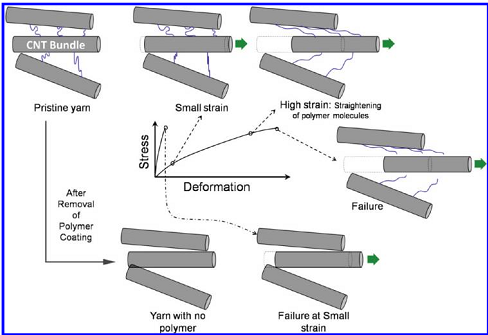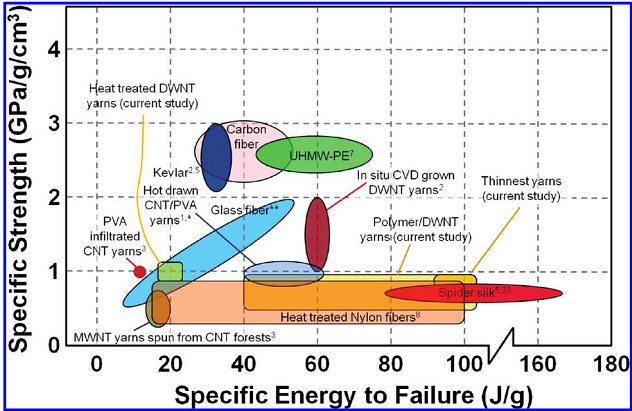
The new material has extremely high specific strength and energy-to-failure ratios. That means that it can absorb a lot of impact without tearing, which in turn means that the force of the impact will spread out rather than be concentrated in a single destructive point. The yarn was produced from double-walled carbon nanotubes and cross-linkable organic polymers like polyvinylalcohol (PVA).
Interestingly, the yarn fibers themselves had strength characteristics slightly inferior to kevlar. For the engineers out there, the maximal reported values for ductility was ~20%, ~100Jg-1 for the energy to failure ratios, and ~1.4GPa for the specific strength. But when the fiber bundles were woven together, forming a macro-fiber with specific strength of ~6 GPa and energy to failure ratios of ~500Jg-1.

Heat treatment is one key to increasing the energy to failure ratio, likely because it activates the polymer cross-linking.
Engineering professor Horacio Espinosa led the study. He states, "We want to create new-generation fibers that exhibit both superior strength and toughness. A big issue in engineering fibers is that they are either strong or ductile - we want a fiber that is both. The fibers we fabricated show very high ductility and a very high toughness. They can absorb and dissipate large amounts of energy before failure. We also observed that the strength of the material stays very, very high, which has not been shown before. These fibers can be used for a wide variety of defense and aerospace applications."
The research was significant as past strength tests focused on pure-nanotube mixtures, which had the tendency for the tubes to slip laterally when stressed, weakening the resulting material. The new composite material is much stronger as the polymers fix the nanotubes in place.

The study on the intriguing new material is titled "A Multiscale Study of High Performance Double-Walled Nanotube−Polymer Fibers" and is published in the journal ACS Nano.
While future work will focus in part on refining the material strength even further, the crucial next step will be refining methods to mass produce the fibers. A great deal of work has already been put into mass producing carbon nanotubes, so commercial super-strong carbon-polymer-based body armor may not be as far off as one might think.



Reader Comments
to our Newsletter